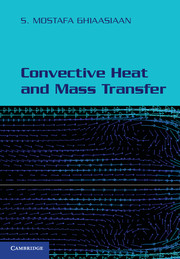Book contents
- Frontmatter
- Contents
- Preface
- Frequently Used Notation
- 1 Thermophysical and Transport Fundamentals
- 2 Boundary Layers
- 3 External Laminar Flow: Similarity Solutions for Forced Laminar Boundary Layers
- 4 Internal Laminar Flow
- 5 Integral Methods
- 6 Fundamentals of Turbulence and External Turbulent Flow
- 7 Internal Turbulent Flow
- 8 Effect of Transpiration on Friction, Heat, and Mass Transfer
- 9 Analogy Among Momentum, Heat, and Mass Transfer
- 10 Natural Convection
- 11 Mixed Convection
- 12 Turbulence Models
- 13 Flow and Heat Transfer in Miniature Flow Passages
- APPENDIX A Constitutive Relations in Polar Cylindrical and Spherical Coordinates
- APPENDIX B Mass Continuity and Newtonian Incompressible Fluid Equations of Motion in Polar Cylindrical and Spherical Coordinates
- APPENDIX C Energy Conservation Equations in Polar Cylindrical and Spherical Coordinates for Incompressible Fluids With Constant Thermal Conductivity
- APPENDIX D Mass-Species Conservation Equations in Polar Cylindrical and Spherical Coordinates for Incompressible Fluids
- APPENDIX E Thermodynamic Properties of Saturated Water and Steam
- APPENDIX F Transport Properties of Saturated Water and Steam
- APPENDIX G Properties of Selected Ideal Gases at 1 Atmosphere
- APPENDIX H Binary Diffusion Coefficients of Selected Gases in Air at 1 Atmosphere
- APPENDIX I Henry's Constant, in bars, of Dilute Aqueous Solutions of Selected Substances at Moderate Pressures
- APPENDIX J Diffusion Coefficients of Selected Substances in Water at Infinite Dilution at 25°C
- APPENDIX K Lennard–Jones Potential Model Constants for Selected Molecules
- APPENDIX L Collision Integrals for the Lennard–Jones Potential Model
- APPENDIX M Some RANS-Type Turbulence Models
- APPENDIX N Physical Constants
- APPENDIX O Unit Conversions
- APPENDIX P Summary of Important Dimensionless Numbers
- APPENDIX Q Summary of Some Useful Heat Transfer and Friction-Factor Correlations
- References
- Index
6 - Fundamentals of Turbulence and External Turbulent Flow
- Frontmatter
- Contents
- Preface
- Frequently Used Notation
- 1 Thermophysical and Transport Fundamentals
- 2 Boundary Layers
- 3 External Laminar Flow: Similarity Solutions for Forced Laminar Boundary Layers
- 4 Internal Laminar Flow
- 5 Integral Methods
- 6 Fundamentals of Turbulence and External Turbulent Flow
- 7 Internal Turbulent Flow
- 8 Effect of Transpiration on Friction, Heat, and Mass Transfer
- 9 Analogy Among Momentum, Heat, and Mass Transfer
- 10 Natural Convection
- 11 Mixed Convection
- 12 Turbulence Models
- 13 Flow and Heat Transfer in Miniature Flow Passages
- APPENDIX A Constitutive Relations in Polar Cylindrical and Spherical Coordinates
- APPENDIX B Mass Continuity and Newtonian Incompressible Fluid Equations of Motion in Polar Cylindrical and Spherical Coordinates
- APPENDIX C Energy Conservation Equations in Polar Cylindrical and Spherical Coordinates for Incompressible Fluids With Constant Thermal Conductivity
- APPENDIX D Mass-Species Conservation Equations in Polar Cylindrical and Spherical Coordinates for Incompressible Fluids
- APPENDIX E Thermodynamic Properties of Saturated Water and Steam
- APPENDIX F Transport Properties of Saturated Water and Steam
- APPENDIX G Properties of Selected Ideal Gases at 1 Atmosphere
- APPENDIX H Binary Diffusion Coefficients of Selected Gases in Air at 1 Atmosphere
- APPENDIX I Henry's Constant, in bars, of Dilute Aqueous Solutions of Selected Substances at Moderate Pressures
- APPENDIX J Diffusion Coefficients of Selected Substances in Water at Infinite Dilution at 25°C
- APPENDIX K Lennard–Jones Potential Model Constants for Selected Molecules
- APPENDIX L Collision Integrals for the Lennard–Jones Potential Model
- APPENDIX M Some RANS-Type Turbulence Models
- APPENDIX N Physical Constants
- APPENDIX O Unit Conversions
- APPENDIX P Summary of Important Dimensionless Numbers
- APPENDIX Q Summary of Some Useful Heat Transfer and Friction-Factor Correlations
- References
- Index
Summary
Laminar flow in low-viscosity fluids is relatively rare in nature and industry. Turbulent flow is among the most complicated and intriguing natural phenomena and is not well understood, despite more than a century of study. Nevertheless, out of necessity, investigators developed simple models that can be used for engineering design and analysis.
Turbulent flows at relatively high Reynolds numbers (fully turbulent flows) are characterized by extremely irregular fluctuations in velocity, temperature, pressure, and other properties. At each point the velocity and other properties fluctuate around a mean value.
Turbulent flows are characterized by eddies and vortices. Chunks of fluid covering a wide size range move randomly around with respect to the mean flow. Fluid particles move on irregular paths, and the result is very effective mixing. Even the smallest eddies are typically orders of magnitude larger than the molecular mean free path (MMFP) (in gases) and the intermolecular distances. Within the small eddies, molecular (laminar) transport processes take place, but the interaction among eddies often dominates the overall transport processes and make molecular transport effects unimportant.
With respect to analysis, the Navier–Stokes equations discussed earlier in principle can be applied to turbulent flow as well. However, to obtain a meaningful solution, these equations must be solved in such a way that the largest and smallest eddies in the flow field are resolved. This approach [direct numerical simulation (DNS)] is extremely computational intensive, and it is possible at this time only for simple flow configurations and low Reynolds numbers.
- Type
- Chapter
- Information
- Convective Heat and Mass Transfer , pp. 177 - 207Publisher: Cambridge University PressPrint publication year: 2011
- 1
- Cited by



